In the world of design, UI and UX are often used interchangeably. However, designers have to merge aesthetics, usability, component placement, layout, spacing, and typography to create meaningful and functional interfaces. All these factors of visual design influence significant interactions and drive conversions for a business. All of this sums up to User Experience (UX), a broader term in design. UX Design is a designing process that supports the user’s behavior and includes usability, desirability, and relevance to improve the interactions with a product. On the contrary, visual design is about enhancing the aesthetic appeal of a product/service. The common approaches to improving visual design include adding a new color, layout, spacing, etc. The problems with visual design can discourage users from discovering all the intelligent choices for navigation or interactions in a design. Therefore, a visual design should focus on the essential elements and actions that a user is expected to perform. It should make designs balanced, fresh, robust, and functional. In recent times, designers are leveraging UX design more than visual design to deliver exceptional design quality.
Don Norman, the inventor of the term “User Experience,” emphasized its importance with this quote. “No product is an island. A product is more than the product. It is a cohesive, integrated set of experiences. Think through all of the stages of a product or service – from initial intentions through final reflections, from the first usage to help, service, and maintenance. Make them all work together seamlessly.” This blog will help you better understand UX design and virtual design, how they’re related, and why UX is stronger than Visual Design.
Visual Design – A Closer Look
Visual design focuses on increasing the aesthetic quotient of a product/service. The focus of visual designers is more on placing all the elements carefully so that the user experience is optimized. Visual designers want to drive as much traffic/conversion to an app/website by uplifting the visual representation. Users/website visitors don’t like to spend much time on a website that takes too long to load or is not visually appealing enough. Hence, visual designers also play a critical role.
Visual Design Elements
The fundamental elements used in the visual design space include:
- Lines: (straight/ geometric/curved/organic) are used to create divisions, shapes, and textures.
- Shapes: Created using lines, colors, gradients, shadows, etc., to form enclosed areas.
- Negative space/whitespace: Designers can use the blank area around a visible or “positive” shape to create a figure or calm the design overall.
- Volume: This is used to display the fullness of three-dimensional images on two-dimensional screens.
- Value: This is used to relate lightness and darkness utilizing a light source to create shadows and highlights.
- Color: Using different colors can help set the tone/theme and grab the user’s attention.
- Texture: This helps provide different variants of an object’s surface.
Guiding Principles of Visual Design
Unity – This relates to the harmony between various page elements. They need to be cohesive and related to ensure that the users aren’t challenged by chaotic (misaligned or disconnected) layouts.
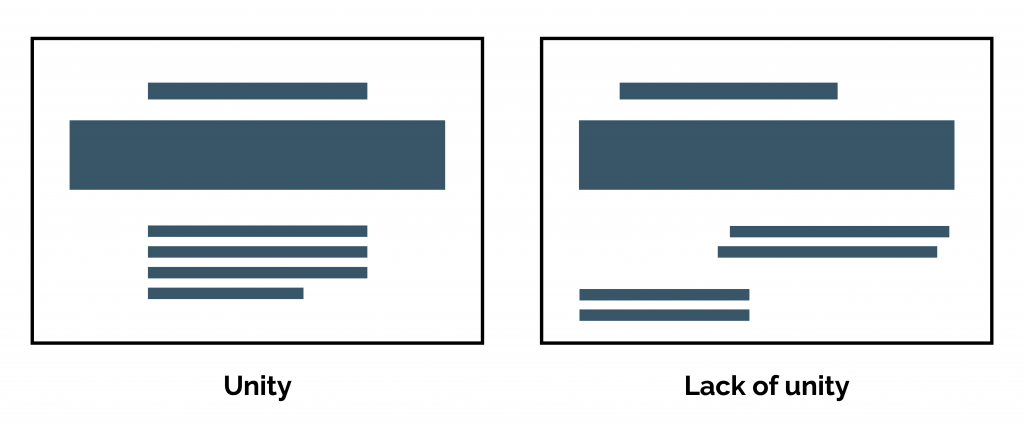 Gestalt – These principles define how people perceive objects and use your design based on their interpretation.
Gestalt – These principles define how people perceive objects and use your design based on their interpretation.
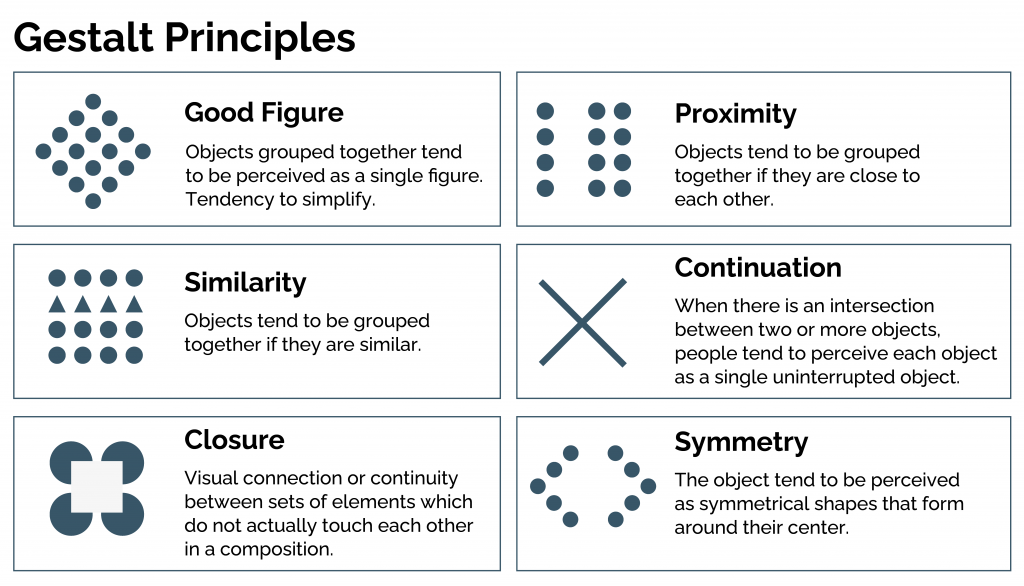 Hierarchy – The most important elements are highlighted using placement, font, color, etc., while the related or less important ones are displayed using a different color/font/placement scheme.
Hierarchy – The most important elements are highlighted using placement, font, color, etc., while the related or less important ones are displayed using a different color/font/placement scheme.
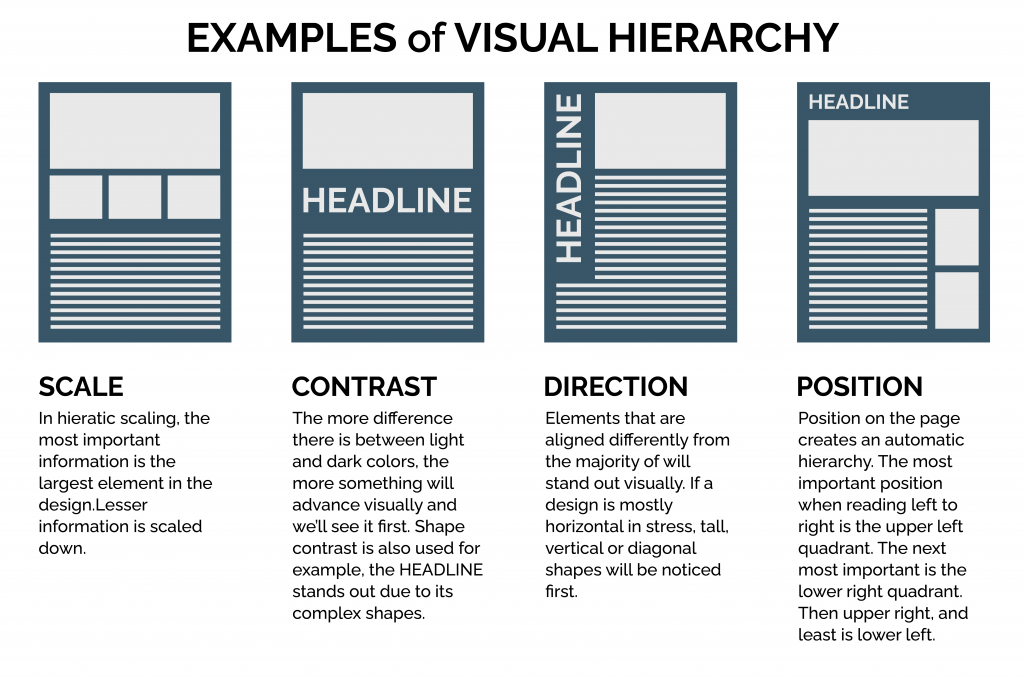 Balance – This ensures the even distribution of elements based on the screen space, orientation, and other factors.
Balance – This ensures the even distribution of elements based on the screen space, orientation, and other factors.
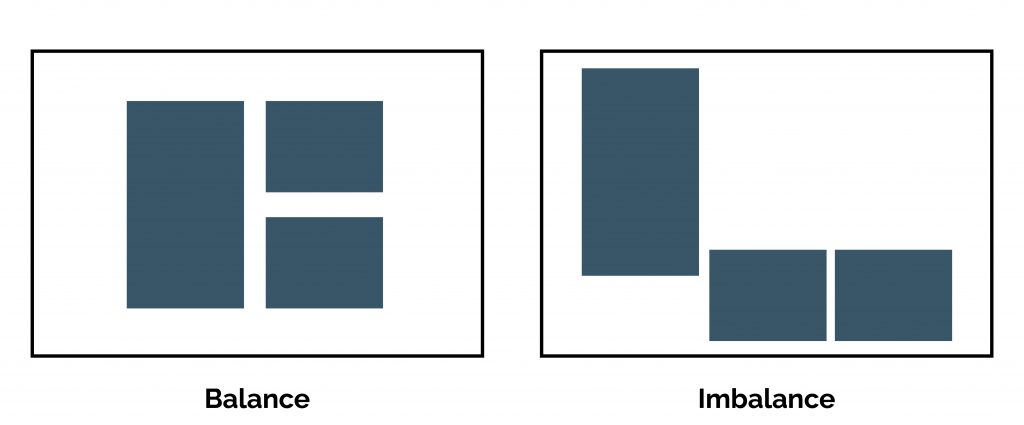 Contrast – This is used to accentuate and emphasize some aspects while dimming the others.
Contrast – This is used to accentuate and emphasize some aspects while dimming the others.
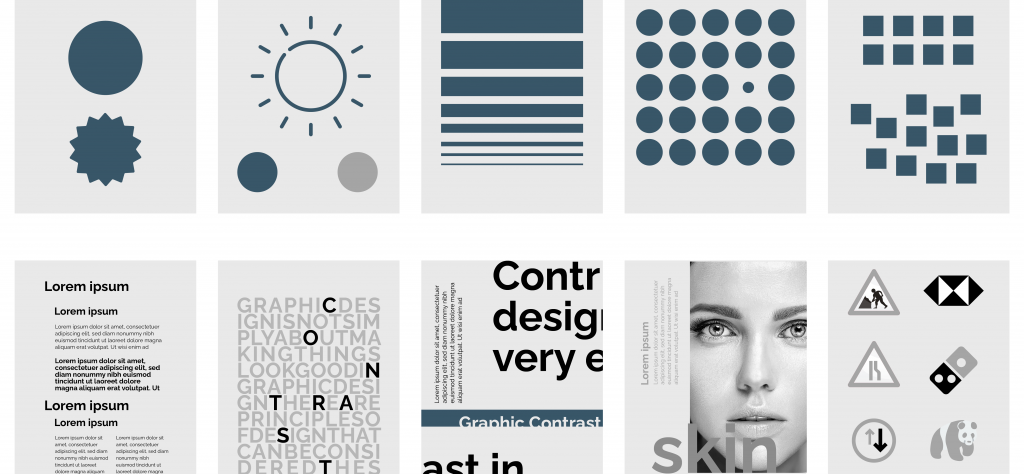 Scale – This helps increase or decrease the emphasis of an element to signify its importance or depth by making it larger or smaller than other elements.
Scale – This helps increase or decrease the emphasis of an element to signify its importance or depth by making it larger or smaller than other elements.
 Dominance – This helps use a component’s size, color, shading, etc., to make it stand out.
Dominance – This helps use a component’s size, color, shading, etc., to make it stand out.
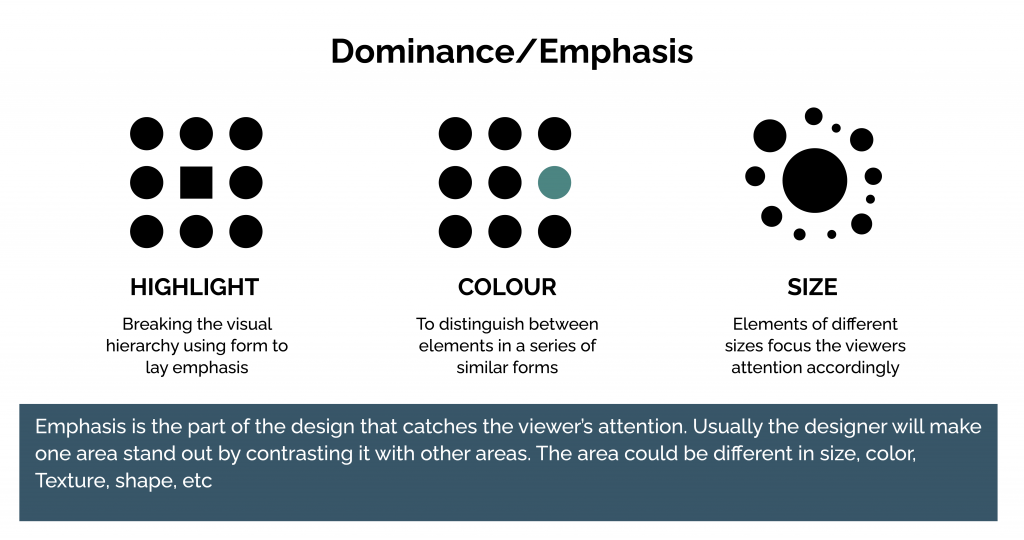 Defining UX Design
Defining UX Design
UX design is about designing an entire process with the intent to improve users’ experience. Some of the essential activities that are part of the UX designing process include integrating products, adding critical branding aspects like logo, theme color, improving the usability of the apps, and so on. UX design is a vast area, and UX designers cover many more activities at once. They always focus on ensuring that the users acquire relevant experience while using an app and their needs are also fulfilled.
Fundamental Principles of UX Design
Higher Focus on User Needs: It is the most fundamental principle of UX designing. According to this principle, users’ convenience and relevance should be the most crucial aspect of any UX design project. We often observe that designers get influenced by competition, and they end up designing complex websites/apps to impress fellow web designers. What they forget is that the primary aim of UX design is to fulfill the users’ needs.
Consistency: The secret to creating any successful website is consistency. UX designers should ensure that the design and functionalities of all the web pages are the same. Users most often come to your website or download your app with some pre-defined expectations. It is a designer’s responsibility to respect them. And consistency is something most users expect. Consistency saves their time and helps them navigate your website without any confusion.
Context Alignment: Any UX designer must interact with the target users before the designing process. That helps them understand the app context and assists them in the ideation and designing phase. UX designers should consider running user surveys as a “must” activity before starting any designing process. That helps them build a broad idea of what the users need, what they are missing, what they don’t like.
Accessibility: Another essential principle is developing designs that are accessible. By accessible, we mean designs that are available to everyone. The list of “everyone” includes people with disabilities as well. An app that is equally accessible to all groups of people can quickly become a success.
Usability Testing: The final UX design principle is about constant usability testing. The intent is that designers should never stop collecting feedback from the users and run their usability tests even after the website or application goes live. UX designing is an iterative process.
What do UX Designers do?
UX designers do much more than simply User Interface designing. Apart from designing an entire process, UX designers are also involved in doing the following:
- Conducting detailed user research
- Validating the UIs from time to time to ensure users’ needs are met
- Writing UX copies
- Presenting the UX design to the marketing team/board members
In short, the responsibilities of a UX designer begin long before the users get hold of the website/app.
How UX Design and Visual Design (UI) Differ?
A virtual design is all about making an application or website look good. It includes creating appeal and organizing elements to:
- Lead users to a component’s functionality.
- Improve aesthetic consistency.
- Remove uncertainty.
- Reduce cognitive on the user and improve memory.
Alternatively, UX design takes care of website mapping, planning the website flows, focusing on user journeys, and most importantly, help the users navigate across web pages with ease and a logical flow.
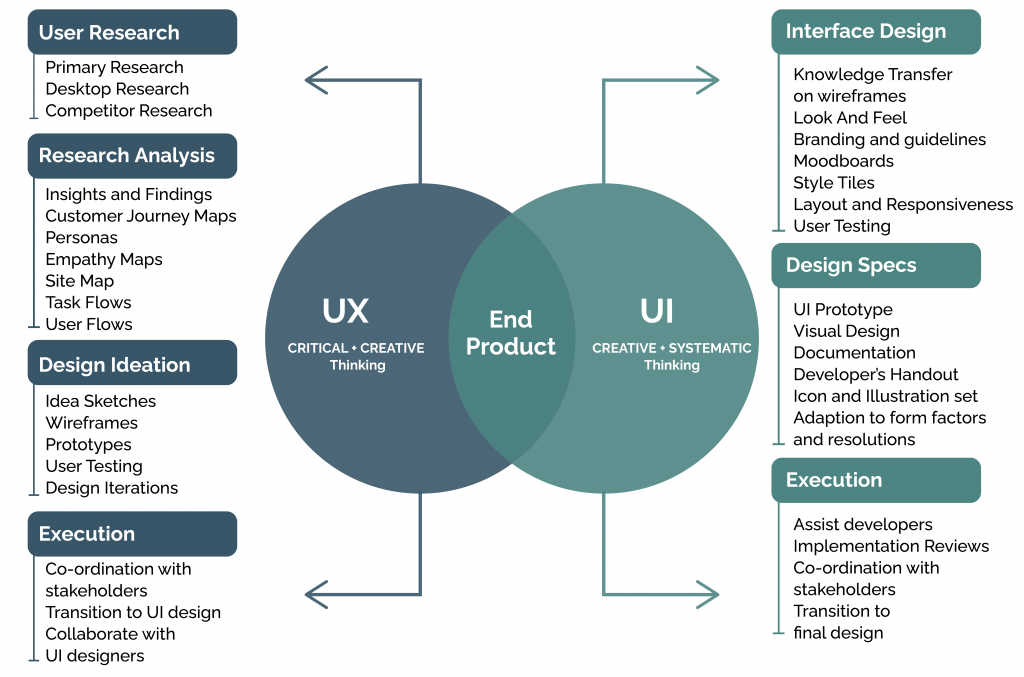 To summarize:
To summarize:
- UX design helps identify and solve user problems, while visual design helps create aesthetically pleasing, intuitive, and interactive interfaces.
- UX design is the first stage in the product development process that UI follows. The UX designer works on the user journey map (blueprint) while the visual designer fills in the details of the visual and interactive elements.
- UX refers to a product, service, or experience, while visual design is specific to digital products and experiences.
- A UX designer needs to consider solving practical design problems (using tasks, user pain points, user research, steps, etc.). In contrast, a visual designer needs to focus only on the various aspects of a design.
How are UX Design and Visual Design Related?
The reality is that both UX Design and Visual Design go hand in hand. Both of these are crucial parts of successfully launching a website or an application. Visual design is an aesthetic extension of UX design. Modern users need more than beautiful and compelling animations on a website. They also seek top-notch functionalities and features. Similarly, users don’t like working on a website that may function as per their expectations but doesn’t look good. So, UX design and visual design are the same tree branches and complement each other. Here’s how UX designers and Visual Designers can work together.
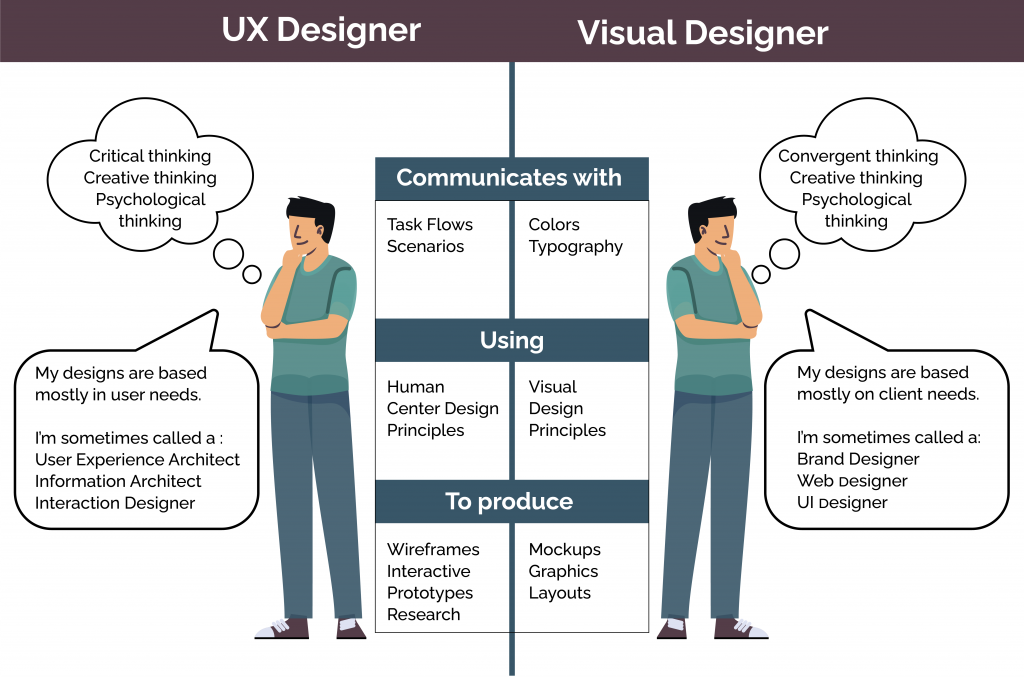 Advantages of UX Design over Visual Design
Advantages of UX Design over Visual Design
Better Visibility on the User’s Problems: Unlike Visual Design, UX designers have excellent prospects to understand the problems and issues faced by users. UX designers can directly connect with the users to encounter their concerns and to offer them effective solutions. Visual designers don’t always get the chance to interact directly with the users. This can create a communication gap. This communication gap often creates roadblocks, and they may not always stay updated with the industry trends.
UX Design can validate the Underlying Concepts: There is no place for any conjecture in UX design. UX designers are constantly testing different products and designs to validate the underlying designs and concepts. However, for visual designers, validation or iterative designs are not part of their job bucket. As a result, their jobs may seem monotonous at times.
UX Design can also Improve Sales and Engagement: Some parts of sales and design may depend on visual designers as individuals can sometimes make decisions based on the visual representation of a website/app. However, in most cases, UX design has a more significant role to play when it comes to increasing sales and engagement. UX designers have a deeper understanding of the users’ perceptions, and accordingly, they plan the website template, its projections, its features, etc. It makes their jobs interesting to interact with audiences and to improve a product’s longevity based on the interactions.
Concluding Thoughts
Both UX design and visual design equally contribute to a website or application’s professional and successful development. Nevertheless, UX design does have the edge over visual design. UX designers interact closely with target audiences, understand their emotions and expectations, and get a better picture of what to create. That’s why they get several chances of skill improvement. On the contrary, visual designers are concerned about the creative aspects, and audience-interaction is not a part of their jobs. That can be a disadvantage at times. Other than that, UX design and Visual design rely on each other to make designs meaningful and exceptional. Connect with Radiant’s UX design team to learn more!


